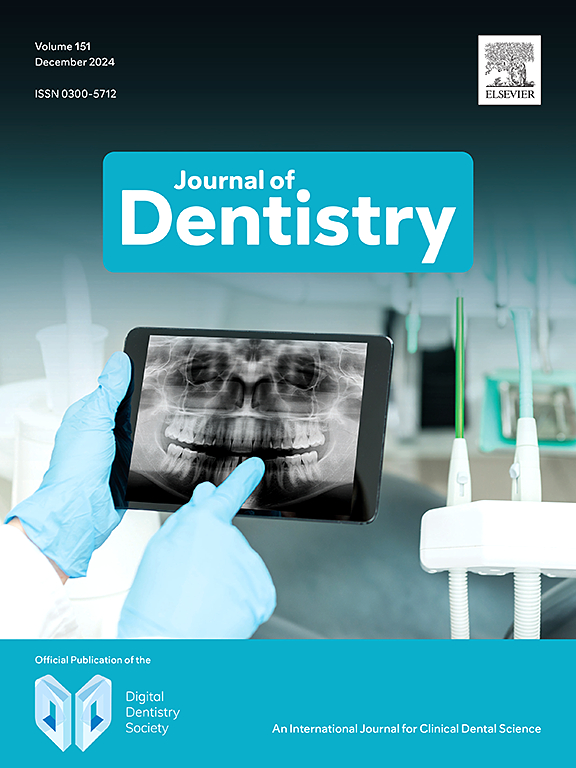基于非图像电子牙科记录的机器学习个性化牙周炎风险分析。
IF 4.8
2区 医学
Q1 DENTISTRY, ORAL SURGERY & MEDICINE
引用次数: 0
摘要
目的本研究旨在开发一种基于非图像电子牙科记录(EDR)的机器学习模型,以预测牙周病(PD)的风险:通过使用 BigMouth 存储库中收集的电子牙科病历,纳入了美国的牙科患者。根据牙周病诊断、治疗和牙周袋,患者被标记为病例或对照。通过学习他们的数据,训练出一个模型。通过准确性、灵敏度、特异性和曲线下面积 (AUROC) 评估了所开发模型预测 PD 的能力,并确定了最重要的特征。表现最佳的模型被应用于验证集:最终研究对象包括 43 331 名参与者。基于开发集,与其他四种 ML 和深度学习技术相比,随机森林模型具有较高的灵敏度(81%)和出色的 AUROC(94%)。最重要的预测因素是出血比例、年龄、就诊次数、先前的预防性治疗、吸烟和用药情况。当该模型应用于验证集时,几乎可以检测到所有病例(91%),但高估了对照组(特异性=0.54)。当在诊断出脊髓灰质炎前3年检索电子病历时,对脊髓灰质炎的预测仍然敏感(89%):结论:基于一致且完整的电子病历,ML 在协助早期发现和预防脊髓灰质炎病例方面具有出色的能力。需要进一步开展研究,对高风险控制进行跟踪,并改进模型的内部和外部验证。改进电子病历记录是重要的第一步:如果这种 ML 模型能应用于临床,就能帮助临床医生根据个人情况进行个性化风险预测。如果揭示/提供了个人的关键风险诱因,ML 就能提出有针对性的预防干预建议。这些进步有助于减少工作量、可持续的电子病历、基于数据的牙科护理,并最终改善患者的治疗效果。本文章由计算机程序翻译,如有差异,请以英文原文为准。
A personalized periodontitis risk based on nonimage electronic dental records by machine learning
Objective: This study aimed to develop a machine-learning (ML) model to predict the risk for Periodontal Disease (PD) based on nonimage electronic dental records (EDRs).
Methods: By using EDRs collected in the BigMouth repository, dental patients from the US were included. Patients were labeled as cases or controls, based on PD diagnosis, treatment and pocketing. By learning from their data, a model was trained. The ability of the developed model to predict PD was evaluated by the accuracy, sensitivity, specificity and area under the curve (AUROC) and the most important features were determined. The best-performing model was applied to the validation set.
Results: The final study population included 43,331 participants. Based on the development set, the Random Forest model performed with high sensitivity (81 %) and had an excellent AUROC (94 %), compared to four other ML and deep learning techniques. The most important predictors were bleeding proportion, age, the number of visits, prior preventive treatment, smoking and drugs usage. When the model was applied to the validation set, the model could detect almost all cases (91 %), but overestimated controls (specificity=0.54). When EDRs were retrieved 3 years before the PD diagnosis, the predictions for PD were still sensitive (89 %).
Conclusion: Based on consistent and complete EDR, ML has an excellent ability to assist with the early detection and prevention of PD cases. Further research is required to follow-up high-risk controls and improve the model's internal and external validation. Improved EDR documentation is an important first step.
Clinical significance: If such ML models become clinically applied, clinicians can be assisted with personalized risk predictions based on the individual. If the key riskcontributing factors for the individual are revealed/provided, ML can suggest targeted prevention interventions. These advancements can contribute to a reduced workload, sustainable EDRs, data-based dental care, and, ultimately, improved patient outcomes.
求助全文
通过发布文献求助,成功后即可免费获取论文全文。
去求助
来源期刊

Journal of dentistry
医学-牙科与口腔外科
CiteScore
7.30
自引率
11.40%
发文量
349
审稿时长
35 days
期刊介绍:
The Journal of Dentistry has an open access mirror journal The Journal of Dentistry: X, sharing the same aims and scope, editorial team, submission system and rigorous peer review.
The Journal of Dentistry is the leading international dental journal within the field of Restorative Dentistry. Placing an emphasis on publishing novel and high-quality research papers, the Journal aims to influence the practice of dentistry at clinician, research, industry and policy-maker level on an international basis.
Topics covered include the management of dental disease, periodontology, endodontology, operative dentistry, fixed and removable prosthodontics, dental biomaterials science, long-term clinical trials including epidemiology and oral health, technology transfer of new scientific instrumentation or procedures, as well as clinically relevant oral biology and translational research.
The Journal of Dentistry will publish original scientific research papers including short communications. It is also interested in publishing review articles and leaders in themed areas which will be linked to new scientific research. Conference proceedings are also welcome and expressions of interest should be communicated to the Editor.
 求助内容:
求助内容: 应助结果提醒方式:
应助结果提醒方式:


